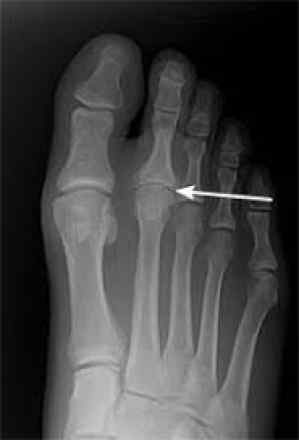
Freiberg’s disease is a poorly understood disorder most commonly of the second metatarsal head in which a portion or all of the metatarsal head loses its structural integrity, which can lead to collapse of the joint surface and pain in the second metatarsophalangeal (MTP) joint. The process by which this loss of integrity and possible collapse happens is not well understood. Due to the fact that the affected area is often well circumscribed, the principle problem has traditionally been thought to be a vascular one.
Basically, the blood supply to part of the bone of the metatarsal head for whatever reason is diminished or cut off. Freiberg’s disease, also called Freiberg’s infraction, is part of a group of disorders called osteochondroses, most of which affect pediatric patients, although Freiberg’s is more common in adults.
Freiberg disease is a common cause of pain in the ball of the foot. The cause is injury to the bone. This disorder usually occurs in girls who are going through puberty and who are growing rapidly or in people in whom the bone connected to the base of the big toe is short or the second metatarsal bone is long. In both cases, the second metatarsal head can be subjected to repeated stresses such as during dancing, jogging, or running.
Signs & Symptoms
The pain is most pronounced in the forefoot at the metatarsal head with weight bearing, particularly when pushing off or when wearing high-heeled footwear. The metatarsophalangeal joint may also be swollen and have limited and painful passive range of motion.
Diagnosis
- X-rays
Doctors do x-rays to confirm the diagnosis of Freiberg disease.
Treatment Options
The treatment of Freiberg's disease depends on many factors, including the severity of condition; the signs and symptoms present; and the age of the patient. The primary goal of therapy is to rest the joint and reduce pain and swelling. A more conservative treatment approach is typically attempted initially which may include modification of activities with different types of casts, crutches and/or shoe inserts, as needed. Medications such as nonsteroidal anti-inflammatory drugs (NSAIDs) may be recommended to manage pain.
To relieve painful flare-ups, doctors may inject corticosteroids and tell people to rest and keep weight off their foot.
- Corticosteroid injections
- Footwear changes or orthoses
- Rarely surgery
Low-heeled shoes, possibly those that have thicker soles than normal and rounded heels, or inserts or other devices placed in the shoe that change the position or range of movement of the foot to relieve pressure on the affected joints or painful areas (orthoses) are helpful.
Rarely, doctors may surgically remove the second metatarsal bone to relieve pain that is difficult to manage.
Causes
The exact cause of Freiberg's disease is poorly understood. Some scientists believe that it is a multifactorial condition which is likely associated with the effects of multiple genes in combination with lifestyle and environmental factors. However, most current theories are centered on whether the triggering event is predominantly traumatic (injury-related) or vascular (consistent with avascular necrosis - an injury to the blood supply of the affected part of the foot).
References:
https://rarediseases.info.nih.gov/diseases/2380/freibergs-disease
https://emedicine.medscape.com/article/1236085-treatment
https://www.msdmanuals.com/professional/musculoskeletal-and-connective-tissue-disorders/foot-and-ankle-disorders/freiberg-disease#v27854821
https://www.msdmanuals.com/home/bone,-joint,-and-muscle-disorders/foot-problems/freiberg-disease
https://www.podiatrytoday.com/key-insights-treating-freiberg’s-infraction
https://radiopaedia.org/articles/freiberg-disease
https://patient.info/doctor/freibergs-disease

